1
More than 75 years have passed since flamboyant, French born, American millionaire Charles Bedaux's attempted to cross north eastern British Columbia with Citroen half track vehicles and over 100 head of horses. Over the years, many articles have been written about Bedaux, his motives and the successes and failures of the expedition, but to date there is little on the record about the role and contribution of the expedition's cowboys and crew. Close to 50 men assisted and accompanied the expedition and many of these called Northern BC home and their experience gained packing, trapping, and guiding was invaluable. A number of the crew kept diaries and journals of the trip which document their unique role and provide a different perspective on this expedition. Bedaux offered the following comments to an Edmonton Journal reporter. "Let me say one word for the spirit of our party. I could never have believed that men would do so much, would risk their very lives, time and time again for the wage of 4 dollars a day. A spirit grew amongst the party and each would try to outdo the other for the good of the whole"
2
Charles Bedaux In His Tent!
1934
On the Trail, Between Fort St. John and Halfway River
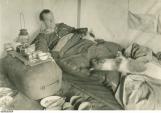 Credits:
Credits:
Bob White
3
Bedaux had been on an extensive hunting trip to north eastern BC in 1932, and guides and packers from that trip became key members of the 1934 expedition. Jack Bocock, an Alberta Geologist, had worked on the Pacific Great Eastern railway survey out of Hudson's Hope, BC in 1930, knew the country and the people, and was designated second in command of the 1934 expedition. Over the winter of 1933-4, he coordinated arrangements from his base in St Albert, with Bedaux in France and New York. Fort St John's Bill Pickell was recruited to buy horses and rigging and scoured the Peace River country to obtain the best of pack and saddle stock. The initial trail cutting contract was taken on by Tommy Wilde, of North Pine (north of FSJ), who returned to cook and entertain the main party. Hudson's Hope's Bob Beattie said he had "never enjoyed a trip more than the one in 1932", and he was hired on as head packer.
4
Bedaux Hunting Party
20th Century, Circa 1932
Hudson's Hope, BC

5
Bedaux party and Beattie Family
1934
Hudson's Hope, BC
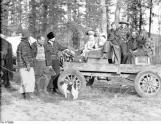 Credits:
Credits:
Unknown
6
Crew of 1932 Bedaux Hunting Party
20th Century, Circa 1932

7
Correspondence between Bocock to Bedaux Apr16/1934
16 April 1934
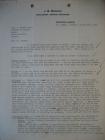
8
The first advance outfit was Tommy Wilde's trail cutting crew that left Fort St John on April 13 of 1934, with instructions to cut a 6 foot wide tractor trail with wide sweeping turns north to the Prophet River. Eighteen year old Cecil Pickell of Fort St John was designated as horse wrangler, packer and eventually took over the cooking duties from a "Dutchman named Jerry, The three Lundquist brothers, Bill, Bernard and Ingval, who hailed from the farming community of Rose Prairie north of Fort St John, were the main axe-men. For the first 60 miles, there was a road of sorts following the old Northwest Mounted Police Trail up the Halfway River. However, north of Cypress Creek the real work started in widening the faint pack and First Nations trails up the east slope of the Rockies with axe and Swede saw.
9
Tommy Wilde
20th Century, Circa 1934
On the Trail, Between Fort St. John and Halfway River
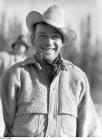
10
Bill Pickell
20th Century, Circa 1934
Fort St. John, British Columbia, Canada
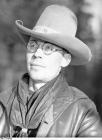
11
Trail Cutting Crew
20th Century, Circa 1934
On the Trail, Between Fort St. John and Halfway River

12
Teepees
1934
Halfway River
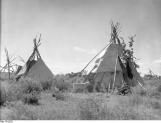
13
Ingwald Lundquist
1934
Sifton Pass, British Colunbia, Canada
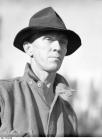
14
Fifty-five year old Ernest Lamarque, a well known Dominion Land Surveyor from Vancouver, was engaged to locate and layout a route through the mountains, and he left. William Blackman of Valemount had proven his packing and bush skills with Lamarque in the past and was accompanied by his brother Henry who become the camp cook. Bocock had recommended Albertans Earl Cushing, who had a mineral engineering background and Art Paul, a 35 year old University of Alberta Agricultural Engineering graduate with a ranch background, and abilities as an axe-man, horseman and veterinarian. Fort St John's, Bill Pickell and Edgar Dopp from Bear Flat on the Peace River accompanied the Lamarque party north to the Prophet River where Dopp had a trapline. There was a fortuitous meeting on the Prophet River with trappers Bert Sheffield, Elmer Gray and Willy Artemenko which gave Lamarque a firsthand perspective of the mountainous country to the west, and helped to focus his trail layout efforts. Dopp and Bill Pickell returned south with the trapper, and Lamarque searched for a suitable route through the mountains. He explored the upper Prophet River, but eventually decided on a route via the Muskwa River, and blazed a trail through the big timber, slides and burnt over country of the upper Muskwa. The Lundquist boys and Cecil Pickell of the Wilde trail cutting crew followed along, widening the trail where they could. The two crews eventually joined forces at the headwaters of the Muskwa river at the end of July.
 Credits:
Credits:







